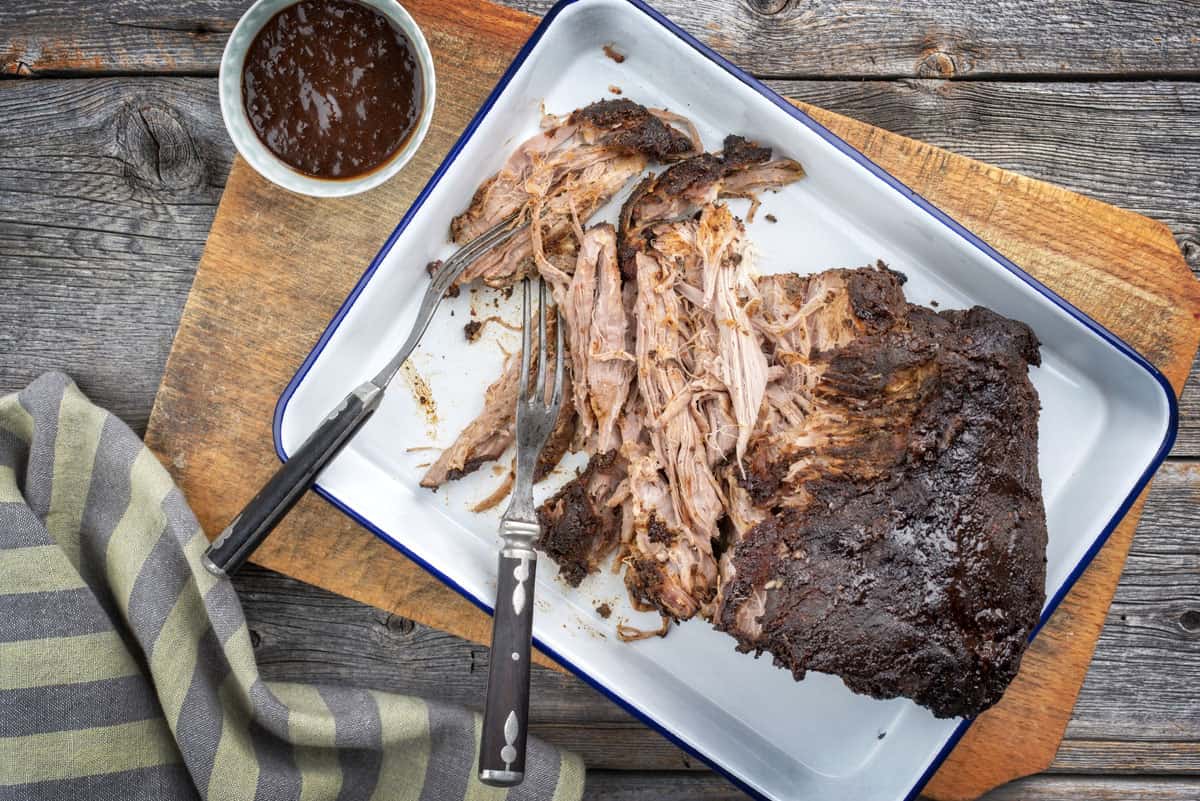
Wrap the meat with more towels as insulation and place into the cooler. Place some towels in the bottom of an empty cooler to protect the plastic from the hot meat. Jeff Savell, professor of meat science at Texas A&M University and an expert on brisket, says about restaurants holding barbecue for 2-4 hours, “My observation is that this rested barbecue…is the best ever produced.”Īt home, you can rest briskets and pork butts just like barbecue competitors and restauranteurs. “It took our quality index from a low A to a high A,” says Mueller. It’s been well documented that some of the best barbecue chefs in America like Aaron Franklin and Wayne Mueller wrap their briskets in butcher paper part way through the cooking process, and when finished hold them in insulated Cambro boxes or custom warming boxes for 2-4 hours or even longer before serving.

When the meat has finished cooking, they allow it to rest in the foil in an empty cooler or insulated Cambro box for several hours where it reabsorbs some of the accumulated liquid before being sliced or pulled for presentation to the judges. Many competition barbecue teams will wrap briskets and pork butts in aluminum foil during the final stages of cooking and add broth, juice, or other flavorful concoctions to the foil package. The gelatin also thickens a bit as the meat cools during the rest, so more of it stays in the meat when sliced or pulled. So why don’t these cuts get tough and dry? Because they contain connective tissue that is converted to gelatin after many hours of “low & slow” cooking, and it’s this gelatin that rehydrates the meat during the resting period. A 2-4 Hour Rest Makes Brisket & Pork Butt Betterīriskets and pork butts are commonly cooked to internal temps as high as 205☏, which drives a lot of moisture out of the meat. Just a 10 minute rest resulted in a 60% decrease in lost liquid, and a 40 minute rest resulted in a 90% decrease of lost liquid-and even after 40 minutes, the internal meat temperature was still hot enough to serve. Here’s how much liquid each roast lost after different resting times: Resting TimeĪmerica’s Test Kitchen Radio, “A New Manifesto for School Lunch”, March 23, 2012 How much moisture is lost when meat is not rested? America’s Test Kitchen Radio did an experiment in which they cooked pork loin roasts at 400☏ to an internal temperature of 140☏.

And since our perception of tenderness is greatly affected by moisture content-moist meat is softer and perceived as being more tender than dry meat-the result is more succulent, tender meat. Rested meat holds on to more of its natural juices-they don’t flood the cutting board when you slice into the meat. As the meat fibers begin to relax, moisture that was driven out is redistributed and reabsorbed by some of the dissolved proteins. When meat is allowed to rest after cooking, this process is partially reversed. You’ll also lose moisture in the form of steam that wafts away from the very hot meat as you cut into it. But for large, fatty cuts of meat that cook to 200-205☏ internal temp, like a brisket or a pork butt, there’s lots of liquid under pressure that will flow out onto the cutting board if you don’t allow the meat to rest. For very lean cuts of meat, like a chicken breast or a pork chop, by the time they reach 170☏ internal temp, most of the moisture has been squeezed out, rendering them tough and dry.

Corriher says that up to 120☏ internal temperature, meat proteins shrink in diameter only and there is little moisture loss, but above 120☏ the proteins also begin to shrink in length-up to half their original length-which forces moisture into the spaces between the muscle fibers and toward the surface and center of the meat. When meat is cooked, muscle fibers begin to compress and contract, which really puts the squeeze on water. According to The Science of Good Cooking, raw beef is about 75 percent water. Meat is muscle, and muscle consists of proteins, fat, vitamins & minerals, and water-lots of water. Allowing almost any meat to rest-whether thick steaks, thick chops, whole turkeys, briskets or pork butts-helps keep meat more moist and improves the texture & tenderness of meat. My experience was an example of why it’s important to let meat rest after cooking. I was surprised to see a flood of juices run out across the cutting board, and when I ate the meat it seemed very dry.

In one of my earliest barbecue experiences, I took a brisket out of the Weber Smokey Mountain Cooker after it was cooked and sliced into it immediately. Why You Should Let Meat Rest After Cooking Cover Loosely With Foil…And When Not To.A 2-4 Hour Rest Makes Brisket & Pork Butt Better.Why You Should Let Meat Rest After Cooking.


 0 kommentar(er)
0 kommentar(er)
